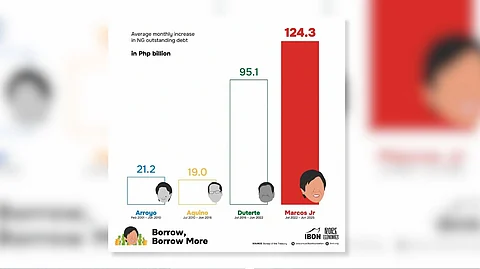
- NEWS
- the EDIT
- COMMENTARY
- BUSINESS
- LIFE
- SHOW
- ACTION
- GLOBAL GOALS
- SNAPS
- DYARYO TIRADA
- MORE

Rising debt payments were the culprit in the balance of payments (BoP) swing to a hefty $5.8 billion (P330.4 billion) deficit in the first seven months, a stark turnaround from the $1.5 billion (P85.4 billion) surplus registered in January to July 2024.
For July alone, the BoP posted a deficit of $167 million (P9.5 billion), reversing the $62 million (P3.5 billion) surplus a year ago, according to a Bangko Sentral ng Pilipinas (BSP) insider.
The deficit mainly reflected the national government’s withdrawals of foreign currency deposits with the BSP to meet external debt obligations.
“The principal factor behind the swing to a $5.8 billion deficit was the substantial outflow of foreign currency stemming from the national government’s scheduled payments on its external debt obligations, which directly reduced the country’s dollar reserves,” a BSP official said on condition of anonymity.
“This situation was amplified by an underlying merchandise trade deficit, where spending on imported goods exceeded earnings from exports, although this was partly mitigated by resilient inflows from overseas Filipino remittances, foreign direct investments, and the government’s foreign currency deposits.”
In the second quarter, total debt amortization reached $7.58 billion (P426.09 billion), or principal payments of $4.5 billion (P252.26 billion) and interest of $3.09 billion (P173.82 billion).
By month, Bureau of Treasury figures showed April outlay of $5 billion (P280.9 billion) or $4.17 billion (P234.45 billion) in principal and $830 million (P46.45 billion) in interest.
In May, $1.42 billion (P80.05 billion), or principal of $180 million (P10.09 billion) and interest of $1.24 billion (P69.95 billion).
In June, the government spent $1.16 billion (P65.14 billion) on its obligations, or $140 million (P7.72 billion) in principal and $1.02 billion (P57.42 billion) in interest.
But beyond debt servicing, BSP data showed that the persistent trade imbalance — where imports continue to far outpace exports — remains the underlying drag on the country’s external position.
Despite the pressures, the BSP emphasized that gross international reserves (GIR) remain “adequate,” at $105.4 billion (P6 trillion) as of end-July, down slightly from $106 billion (P6.04 trillion) in June. The current level is equivalent to 7.2 months’ worth of imports of goods and payments of services and primary income, and about 3.4 times the country’s short-term external debt.
Still, the numbers suggest a more fragile picture. The steady decline in reserves, coupled with a widening trade gap and heavier debt payments, shows that while the buffer is sizeable, it is not immune to sustained outflows. The headline adequacy of GIR may offer comfort, but its gradual erosion underscores the limits of relying on reserves alone to shield the economy.
Global trade remains weak
Robert Dan Roces, chief economist at SM Investments Corp., said the deficit reflects the strain of weak global trade and strong import demand.
“The swing to a BoP deficit this year reflects the widening trade gap with import demand outpacing exports, alongside heavier external debt servicing, and these factors outweighed the steady support from remittances and portfolio inflows,” Roces said.
“Deficits may persist but should narrow toward year-end, leaving the Philippines reliant on its still-comfortable foreign reserves as a buffer.”
The BSP, in its official outlook, expressed confidence that the external accounts will improve in the latter part of the year, citing the traditional surge in remittances during the holiday season and programmed government borrowings that could inject foreign exchange into the economy.
Notably, no BoP report for the second quarter of 2025 has been made available on the BSP’s official website as of this writing, a gap that raises transparency concerns given the importance of timely external sector data.
But with a $5.8 billion (P330.4 billion) deficit already accumulated in just seven months, the fourth-quarter inflows may only partly offset the damage. Unless exports recover and reliance on foreign borrowings eases, the Philippines risks leaning indefinitely on remittances and debt to plug persistent cracks in its external accounts.
